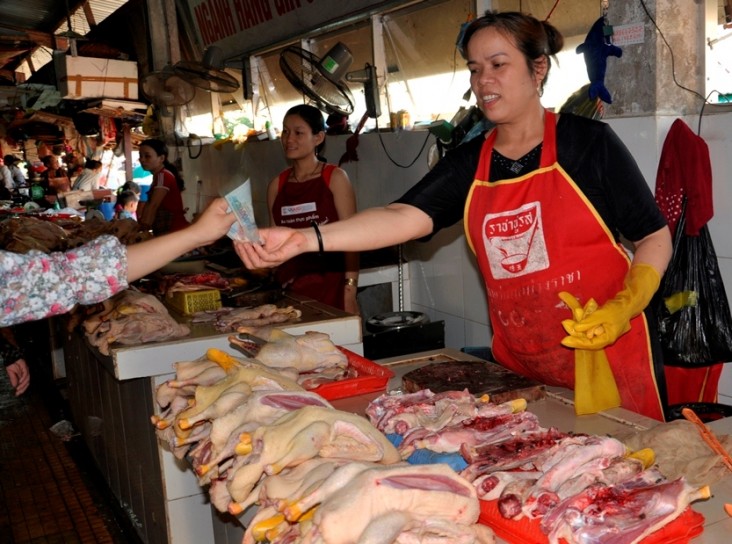
April 2014—Nguyen Thi Thuy owns a small poultry slaughtering facility in the central province of Quang Tri. The 45-year-old woman recalls a time when her family did the poultry slaughtering in poor and unhygienic conditions. The slaughtering area was small and dark, without adequate light and water and was located within the family’s living area. The slaughtering was performed on the floor with no safety practices. For 15 years, the facility operated under the poor conditions.
The business was not good either, with around 60 chickens sold a day. And there were many bird flu outbreaks in the province.
With technical and financial support from USAID’s Avian and Pandemic Influenza Initiative, Thuy made an investment in 2011to renovate the slaughtering area based on a model developed by the project. The model helped Thuy determine necessary renovations: separating the slaughtering area from the family living area, creating a one-way slaughtering line, installing new roofs with increased height and skylights to improve lighting and ventilation, tiling the floors and walls to allow for better cleaning and sanitizing, and providing standard equipment for the processing line. Thuy and five slaughtering workers also received training on risk reduction and safe handling of poultry.
“We now have much better working conditions and my workers enjoy working here. The slaughtering area is much more organized and our products are much cleaner,” said Thuy. “More and more big customers like restaurants and kindergartens want to buy chicken from us after they have seen how we processed chickens in our new and hygienic facility. We often slaughter and sell 100 to 150 chickens every day now, and my family’s income has increased 25 percent over the past year.”
Poor hygiene and sanitation in slaughtering facilities threaten public health as well as livelihoods. In response, USAID developed an effective, simple and inexpensive model for upgrading small, home-based slaughtering facilities to reduce the risks of contamination of poultry products, people and the environment. By September 2013, 25 facilities had been upgraded using the USAID model, which was developed in 2010-2011. With support from USAID in combating highly pathogenic avian influenza and other pandemic threats, the number of bird flu outbreaks in Vietnam dropped from almost 2,000 in 2005 to fewer than 100 in 2013.
The USAID Avian and Pandemic Influenza Initiative, which ran from October 2009 to September 2013, was designed to strengthen the capacity of the Government of Vietnam and its provincial ounterparts to identify, prevent and control outbreaks of avian influenza and other emerging infectious and zoonotic diseases spread between animals and humans. Implemented by Abt Associates, the project began in the provinces of Can Tho, Ha Nam, Hung Yen, Kien Giang and Quang Tri. The focus expanded along poultry supply and value chains into other provinces for wider regional effects. Collaborating closely with the Food and Agriculture Organization, the World Health Organization of the United Nations, and the Partnership on Avian and Human Influenza in Vietnam, the project leverages village, commune, district and provincial experiences and outcomes to provide evidence for planners and policy makers.
Links
Follow @USAIDVietnam, on Faceboook, on Flickr







Comment
Make a general inquiry or suggest an improvement.